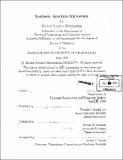| dc.contributor.advisor | Thomas F. Knight, Jr. and Dennis M. Freeman. | en_US |
| dc.contributor.author | Mermelstein, Michael Stephen | en_US |
| dc.contributor.other | Massachusetts Institute of Technology. Dept. of Electrical Engineering and Computer Science. | en_US |
| dc.date.accessioned | 2005-08-23T18:04:07Z | |
| dc.date.available | 2005-08-23T18:04:07Z | |
| dc.date.copyright | 1999 | en_US |
| dc.date.issued | 1999 | en_US |
| dc.identifier.uri | http://hdl.handle.net/1721.1/8178 | |
| dc.description | Thesis (Ph. D.)--Massachusetts Institute of Technology, Dept. of Electrical Engineering and Computer Science, 1999. | en_US |
| dc.description | Includes bibliographical references (p. 134-136). | en_US |
| dc.description.abstract | In the late 1800's, Ernst Abbe, research director of the Carl Zeiss Optical Works, wrote down the rules for a lens to form a sharp image. Advances in communications theory, signal processing, and computers have allowed us.finally to break those rules. Our "Synthetic Aperture Microscope" floods a large region with a richly complex, finely structured pattern of light-the interference pattern of a ring of n coherent sources. A target within the volume of the interference fluoresces (or scatters or transmits) an amount of lights that reveals correspondences with this "probing illumination." Modulating'fthe phases and amplitudes of the n beams with carefully chosen modulation signals causes the probe illumination to step through a predetermined or measured family of patterns. A sensor records the target's response in a time-sequence. This time-sequence contains each of order n2 complex Fourier coefficients of the target. Each of these coefficients is encrypted by a unique spread-spectrum key embedded in the amplitude and phase modulation signals. Signal processing picks out these coefficients to reconstruct an image of the target. Low resolution conventional imaging maps an array of "targets" (actually portions of a larger target) to a CCD array, thus allowing this sensing process to be done in parallel over a large region. The end result is to boost the resolution of a conventional imager by hundreds to thousands of sub-pixels per physical pixel. Both theoretical and experimental work on the engineering to make the concept practical are reported. | en_US |
| dc.description.statementofresponsibility | by Michael Stephen Mermelstein. | en_US |
| dc.format.extent | 136 p. | en_US |
| dc.format.extent | 12344451 bytes | |
| dc.format.extent | 12344204 bytes | |
| dc.format.mimetype | application/pdf | |
| dc.format.mimetype | application/pdf | |
| dc.language.iso | eng | en_US |
| dc.publisher | Massachusetts Institute of Technology | en_US |
| dc.rights | M.I.T. theses are protected by copyright. They may be viewed from this source for any purpose, but reproduction or distribution in any format is prohibited without written permission. See provided URL for inquiries about permission. | en_US |
| dc.rights.uri | http://dspace.mit.edu/handle/1721.1/7582 | |
| dc.subject | Electrical Engineering and Computer Science. | en_US |
| dc.title | Synthetic aperture microscopy | en_US |
| dc.type | Thesis | en_US |
| dc.description.degree | Ph.D. | en_US |
| dc.contributor.department | Massachusetts Institute of Technology. Department of Electrical Engineering and Computer Science | |
| dc.identifier.oclc | 50046170 | en_US |
